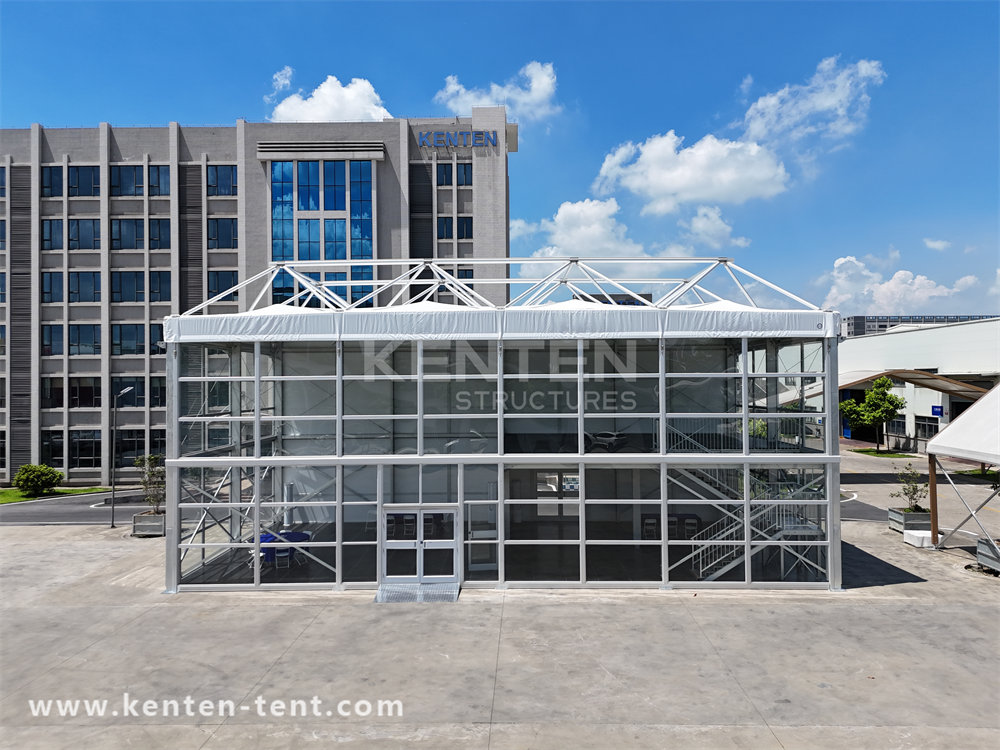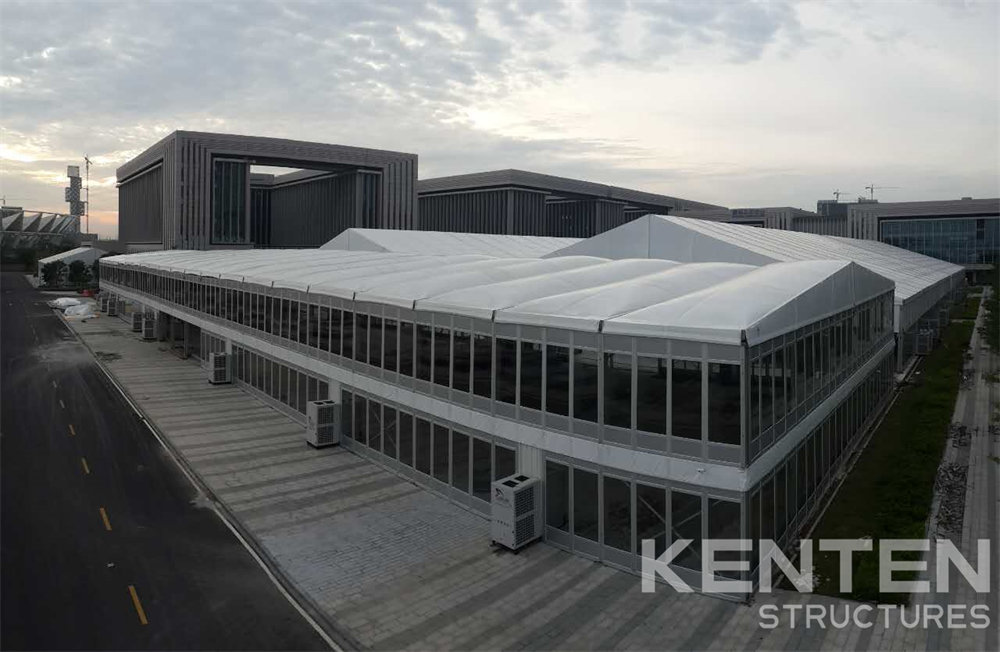



With their three-dimensional space, flexible customization, and efficient construction, two-story tents can play an important role in many areas beyond VIP viewing at sporting events, becoming a multifunctional solution for various scenarios. Whether for commercial events, cultural celebrations, or emergency needs, they can provide high-quality space support with their unique advantages.

In the commercial field, the layered structure of two-story tents can perfectly meet different functional needs and add a sense of professionalism and style to events.
The first floor can be used as a product display area, with open exhibition stands and interactive experience areas, allowing visitors to get a close look at product details; the second floor can be planned as a VIP negotiation area or media interview area, connected by stairs to form an independent and private space. For example, at a car brand launch event, the first floor can be used to display new car models and technical parameters, while the second floor can be used to invite the media and industry experts for in-depth exchanges, ensuring both the openness of the exhibition and the privacy of high-end communication. In addition, the exterior of the tent can be customized with the brand's main colors and logo, and the interior lighting can be adjusted to match the product features, strengthening the brand image.
For small and medium-sized business forums, two-story tents can make efficient use of space: the first floor serves as the main venue, equipped with a large LED screen, audio system, and tiered seating to accommodate hundreds of people; the second floor is set up as a sub-venue or small group discussion room, with soundproofing materials to ensure that each area does not interfere with the other. Compared to traditional hotel conference rooms, this layout is more flexible and can quickly adjust the number of seats according to the number of participants, reducing venue idle costs.

The backstage area of a music festival can be divided into functional areas using two-story tents: the first floor can be used as an artist lounge, dressing room, and equipment storage area, equipped with comfortable sofas, dressing tables, and storage racks; the second floor can be used as a temporary studio for the music production team, equipped with mixing consoles, recording equipment, etc., to facilitate on-site sound adjustments. In art exhibitions, the first floor can showcase large-scale installations or interactive exhibits, while the second floor displays paintings, photographs, and other works. The vertical spatial transition enhances the layered experience of viewing, and the transparent tent fabric design allows natural light to blend with the artworks, creating an immersive viewing experience.
For outdoor weddings, the two-story tent can meet a variety of needs: the first floor can be used as a ceremony area and banquet hall, decorated with flower arches, a stage, and long tables to accommodate friends and family for dining; the second floor can be designed as a dessert area, photo spot, or rest area for friends and family, with a panoramic view of the wedding venue through the viewing window, adding to the romantic atmosphere. Additionally, the tent fabric can be customized in light pink or champagne colors, paired with chandeliers and sheer curtains for decoration, balancing the natural feel of an outdoor wedding with the elegance of an indoor venue, and without being constrained by hotel venue availability, allowing flexible scheduling to match the wedding date.
After a natural disaster, the two-story tent can be quickly converted into a temporary rescue center: the first floor serves as a medical triage area, equipped with examination tables, medicine storage cabinets, and simple hospital beds to provide initial treatment for the injured; the second floor serves as a command and dispatch room and material storage area, storing medical equipment, food, and other supplies, with stairs used to transport them to reduce interference with foot traffic on the ground. Its aluminum alloy frame is wind-resistant and waterproof, providing a safe space for rescue personnel and disaster-affected residents in complex environments. After disassembly, it can be relocated to other disaster areas for reuse, reducing emergency response costs.
When corporate office buildings are being renovated or school buildings are undergoing maintenance, two-story tents can be used as temporary replacement space: the first floor is divided into multiple open office areas or classrooms, equipped with tables, chairs, power outlets, and lighting systems to meet daily work and teaching needs; the second floor is set up as a meeting room, teacher's office, or storage room to ensure the normal functioning of management. Compared with mobile prefabricated houses, tents have a short construction period (usually 1-3 days) and do not cause permanent damage to the ground, making them suitable for short-term transitional use.
High-end campgrounds can introduce two-story tents as special accommodation units: the first floor is a living room and kitchen area, equipped with sofas, dining tables, and simple kitchen utensils to meet the needs of family gatherings; the second floor is a bedroom area with wooden floors and comfortable mattresses, and the top is covered with translucent canvas so that guests can enjoy the starry sky at night. This design retains the natural experience of camping while providing more comfortable living conditions than traditional tents, making it suitable for families with children or couples on vacation.
During the peak tourist season, scenic spots can use two-story tents to alleviate reception pressure: the first floor serves as a ticket information center, souvenir shop, and rest area, equipped with self-service ticket machines and lockers; The second floor serves as a staff lounge and monitoring room, where staff can observe the flow of people in the scenic spot through windows and dispatch service resources in a timely manner. Its mobility allows the scenic spot to adjust its location according to seasonal changes in passenger flow, avoiding idle waste during the off-season.
The diverse applications of two-story tents stem from their efficient use of space and adaptability to different scenarios. Whether it is the professional layout of commercial activities, the creation of a cultural atmosphere, or a quick response to emergency situations, it can provide high-quality solutions with customized designs and stable structures. With the continuous expansion of application scenarios, two-story tents are becoming a flexible choice in modern space solutions, creating more possibilities for various needs. If your project requires functional and flexible space support, two-story tents may bring unexpected results.

Warehouse tents are widely used in warehousing and logistics centers as efficient and flexible temporary or semi-permanent storage solutions

Warehouse tents are flexible, movable temporary storage structures widely used in industry, logistics, agriculture, and commerce to meet space expansion and cost control needs.

Aluminum Structure Tent has emerged in many fields with its smooth curved shape, sturdy structure, and flexible adaptability.